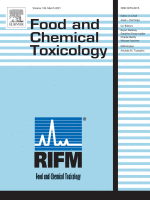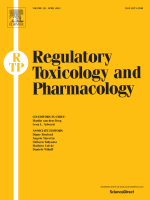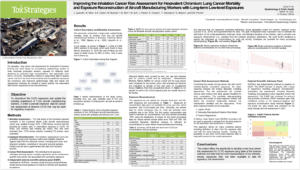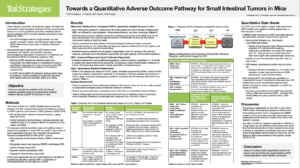ToxStrategies Managing Principal Scientist, Dr. Laurie Haws will speak at The Society of Toxicology’s featured session, Impact on Women in Science, A Career in Advancing the Field of Toxicology: A Tribute to Linda S. Birnbaum, on Wednesday, March 24th, 10:00–11:30 ET.
Author Archives: ToxStrategies
Julie Panko presents workshop at SOT 2021
ToxStrategies scientist, Julie Panko, CIH, will present a workshop at The Society of Toxicology’s virtual meeting. The workshop session is titled, Challenges in Characterizing Environmental Health Risk of Microplastics: Experiences from the Tire Industry Project Related to Tire and Road Wear Particles, and will take place Monday, March 22nd, from 11:15 to 11:35 ET. Ms. Panko’s presentation is part of the main session, titled, Tackling the Potential Human Health Impacts of Microplastics and Nanoplastics: Challenges for Toxicologists in the Assessment of Real-World Complex Mixtures.
New study of steviol glycosides indicates lack of carcinogenicity
 An article published recently by ToxStrategies scientists presents the systematic identification, appraisal, and integration of mechanistic data in an assessment of the potential carcinogenicity of steviol glycosides, a naturally occurring, non-nutritive sweetener. Based on an evaluation of more than 900 measurements/assay endpoints related to one or more key characteristics of carcinogens (KCC) reported in the literature or within the ToxCast/Tox21 high-throughput screening data, the authors found a lack of evidence for activity across the mechanistic database. The assessment included individual steviol glycosides, as well as mixtures such as whole stevia leaf extracts. These results align with the overall lack of tumor response to steviol glycosides observed in mammalian carcinogenicity studies, corroborating previous reports of a lack of carcinogenicity related to steviol glycoside exposure. This open-access publication is the fourth in a series of assessments for non-nutritive sweeteners, following aspartame, sucralose, and acesulfame potassium (Ace K), all of which have been published in Food and Chemical Toxicology.
An article published recently by ToxStrategies scientists presents the systematic identification, appraisal, and integration of mechanistic data in an assessment of the potential carcinogenicity of steviol glycosides, a naturally occurring, non-nutritive sweetener. Based on an evaluation of more than 900 measurements/assay endpoints related to one or more key characteristics of carcinogens (KCC) reported in the literature or within the ToxCast/Tox21 high-throughput screening data, the authors found a lack of evidence for activity across the mechanistic database. The assessment included individual steviol glycosides, as well as mixtures such as whole stevia leaf extracts. These results align with the overall lack of tumor response to steviol glycosides observed in mammalian carcinogenicity studies, corroborating previous reports of a lack of carcinogenicity related to steviol glycoside exposure. This open-access publication is the fourth in a series of assessments for non-nutritive sweeteners, following aspartame, sucralose, and acesulfame potassium (Ace K), all of which have been published in Food and Chemical Toxicology.
New article encourages diligence in classifying chemicals’ carcinogenicity

BHA (butylated hydroxyanisole) is one of many synthetic antioxidants used in food, food packaging, pharmaceuticals, and cosmetics. Since 1947, BHA has been added to fat-containing foods as an antioxidant to preserve the food and prevent the loss of certain vitamins. However, the International Agency for Research on Cancer (IARC) has classified BHA as “possibly carcinogenic to humans,” because it was linked to tumor formation in rats exposed to high levels. IARC later determined that the cancer-causing mechanism in rats isn’t relevant to humans, but the classification has not been rescinded. Based on this misclassification, BHA is listed as a regulated chemical under California’s Proposition 65, and much consumer concern has arisen regarding the safety of BHA-containing food. A paper just out by a team that includes Dr. Chad Thompson, of ToxStrategies, concludes that the body of evidence on BHA does not support a causal connection between BHA at permitted levels in food and any form of cancer. The authors point out that such misclassifications can cause undue concern and potential over-regulation, and do not benefit human health. The paper appears in Regulatory Toxicology and Pharmacology and can be viewed here.
ToxStrategies presents at SOT 2021
ToxStrategies scientists have the following posters available for viewing via The Society of Toxicology’s virtual meeting platform, March 12th through May 31st, as well as live poster sessions for direct questions and answers. Please click on the poster image to view the full abstract and live session information.
Ms. Deborah Proctor: Improving the Inhalation Cancer Risk Assessment for Hexavalent Chromium: Lung Cancer Mortality and Exposure Reconstruction of Aircraft Manufacturing Workers with Long-Term Low-Level Exposures
Dr. Chad Thompson: Toward a Quantitative Adverse Outcome Pathway for Small Intestinal Tumors in Mice
SOT Annual Meeting & ToxExpo
The Society of Toxicology will host their virtual event on Friday, March 12th, through Friday, March 26th.
The SOT virtual meeting will have three experience versions to choose from, featuring a variety of participation options. This year’s meeting includes more than 65 sessions, 1000 poster presentations, and 40 exhibitor–hosted sessions. Virtual features include SOT TV, Networking through Hallway Huddles Lounge or Tiny Tox Talks, and the SOT Hub.
Preparing for TSCA risk evaluation of metals
To date, U.S. EPA has not selected a metal as a high-priority chemical for risk evaluation under the Toxic Substances Control Act (TSCA). TSCA requires that 50% of all high-priority designations be drawn from the 2014 Update of the TSCA Work Plan and that EPA also gives preference to Work Plan chemicals with the following characteristics: 1) Persistence and bioaccumulation scores of three; 2) Known human carcinogens; or 3) High acute or chronic toxicity. The 2014 Update of the TSCA Work Plan identifies several metals that meet these criteria, including cadmium, lead, cobalt, and antimony. If a metal is selected as a high-priority substance, unlike other substances, the risk evaluation method is specified by statute – specifically EPA is required to use the March 2007 Framework for Metals Risk Assessment of the Office of the Science Advisor.
Metals differ from organic chemicals in a number of ways that are important to environmental and occupational health risk assessment. Key factors for consideration include the natural occurrence of metals mixtures in all environmental media and their complex environmental chemistries that strongly influence their fate and potential for toxicity. Accounting for metal’s speciation, bioavailability, and bioaccumulation is critical to proper exposure assessment. The potential hazard of a metal is governed by its toxicokinetics and toxicodynamics, which are dependent on the form of the metal, metal compound, or mixture. Furthermore, many metals are essential nutrients for living organisms, including humans, and combined nutritional and toxicological effects could occur.
ToxStrategies’ scientists have published research and systematic reviews addressing these complex metals toxicology and risk assessment issues. Our experts have applied the Framework for Metals Risks Assessment to numerous metals for various industrial, occupational, commercial, and consumer conditions of use and are ready to assist clients prepare for the risk evaluations under the TSCA program. Contact us at info@toxstrategies.com to learn more!
New studies published on formaldehyde health effects
ToxStrategies scientists Dr. Chad Thompson, Dr. Allison Franzen, and Ms. Seneca Fitch and their colleagues have published a pair of papers in a special issue of Critical Reviews in Toxicology that celebrates the journal’s 50th anniversary. The two articles focus on the modes of action (MOAs) by which exposure to formaldehyde is related to leukemia and nasal cancer. The topics are timely, in light of USEPA’s designation of formaldehyde as a high-priority substance under the Toxic Substances Control Act. With regard to leukemia, the research consisted of a systematic literature review dealing with such MOAs, concluding that postulated causation of leukemia by formaldehyde intake is not biologically plausible based on current evidence. The other study looked at formaldehyde-induced nasal tumors in rats and their relevance to humans, emphasizing numerous studies published since 2006 and highlighting the evidence for non-genotoxic mechanisms of cytotoxicity and regenerative cell proliferation in the MOA for tumor formation.



